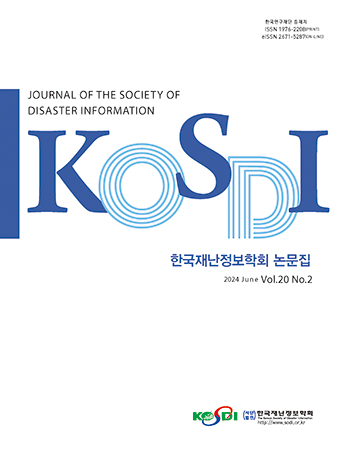Original Article
Abstract
References
Information
Purpose: The objective of this study was to improve the tunnel maintenance and monitoring technology by establishing the maintenance, management, and monitoring standards for shield and TBM tunnels, which had been applied more in recent years. Method: This study comprehensively analyzed and compared the data and model simulations of Seoul Subway Lines 7 and 9 and Bundang Line, shield and TBM tunnels in South Korea, tunnels in France and Japan, and Channel Tunnel in the UK. Result: This study set maintenance and monitoring standards when there was no design estimate based on numerical analyses such as section design and section analysis regarding the maintenance and monitoring section of shield and TBM tunnels. Conclusion: It is necessary to determine safety by comprehensively considering not only each monitoring item but also the changing trend and correlation of all items and compensation of the tunnel.
연구목적: 본 연구는 최근 들어 적용이 확대되고 있는 Shield 및 TBM터널의 유지관리계측 관리 기준을 설정하여 터널 유지관리계측 관리기술을 향상시키고자 한다. 연구방법: 국내 Shield 및 TBM터널인 서울지하철 7호선, 9호선, 분당선, 국외의 프랑스, 일본, 영국의 채널터널 자료와 국내외의 터널 모형실험 사례를 종합적으로 분석하여 상호 비교를 실시한다. 연구결과: Shield 및 TBM 터널의 유지관리계측 단면 중 단면설계나 단면해석 등의 수치해석 결과에 의한 설계 예상치가 없는 경우의 유지관리계측 관리기준을 설정한다. 결론: 계측 관리기준 적용 시 각각의 계측항목 뿐만 아니라 전체 항목의 변화추이와 상관관계, 그리고 터널의 변상 등을 종합적으로 고려하여 안전성 여부를 판정하여야 한다.
- Japan Tunnel Technology Association(JTTA) (1983). Monitoring Management Standards for Tunnel Construction. Tokyo, Japan.
- Ki, J.S. (1999). "Analysis of compensation concrete lining in tunnel." Korean Institute for Structural Inspection, Vol. 3, No. 1, pp. 58-69.
- Kim, H., Kang, M.G. (2007). "Analysis of TBM excavation and drainage management case of the Seoul Subway Section 909." Proceedings of the 8th Tunnel Mechanization and Construction Technology Symposium, Korean Tunnelling and Underground Space Association, Seoul, Korea, pp. 141-152.
- Kim, Y.G. (1998). Lining Model Test for Tunnel Health Evaluation. Daewoo Construction Technology Research Center, Seoul, Korea.
- Lee, D.H. (1998). Mechanical Behavior and Crack Characteristics of Tunnel Concrete Lining. Ph.D. Dissertation, Seoul National University, Korea.
- Maeda, K., Obata, T. (1992). "The monitoring of the behavior at the undersea portion of the Seikan tunnel." Journal of Japanese Tunnelling Association, Vol. 2, pp. 143-148.
- Moore, D., Crease, A. (1996). Tunnel Instrumentation, Engineering Geology of the Channel Tunnel, Gage Technique Ltd, England, pp. 287-294. 10.1680/egotct.20450.0019
- Seoul Metropolitan Subway Construction Headquarters(SMSCH) (2002). Improvement Plan of Seoul Subway Monitoring Management. pp. 70-80.
- Woo, J.T., Lee, K.I. (2012). "A study on establishment of measurement and analysis frequency of maintenance monitoring in tunnel." Journal of Korean Tunnelling and Underground Space Association, Vol. 14, No. 2, pp. 117-129. 10.9711/KTAJ.2012.14.2.117
- Publisher :The Korean Society of Disaster Information
- Publisher(Ko) :한국재난정보학회
- Journal Title :Journal of the Society of Disaster Information
- Journal Title(Ko) :한국재난정보학회논문집
- Volume : 20
- No :1
- Pages :1-12
- DOI :https://doi.org/10.15683/kosdi.2024.3.31.001




 Journal of the Society of Disaster Information
Journal of the Society of Disaster Information







